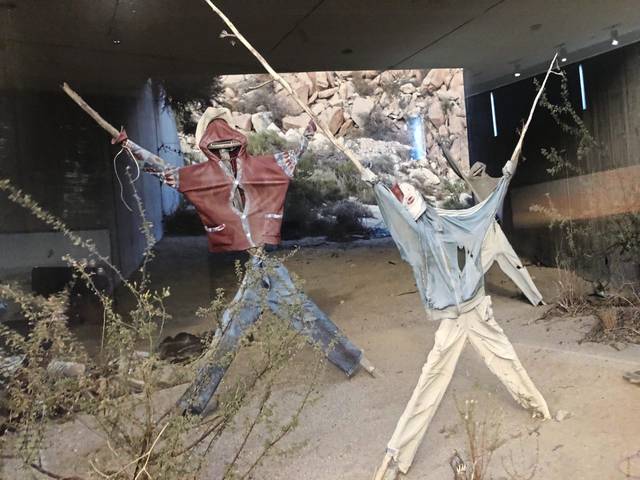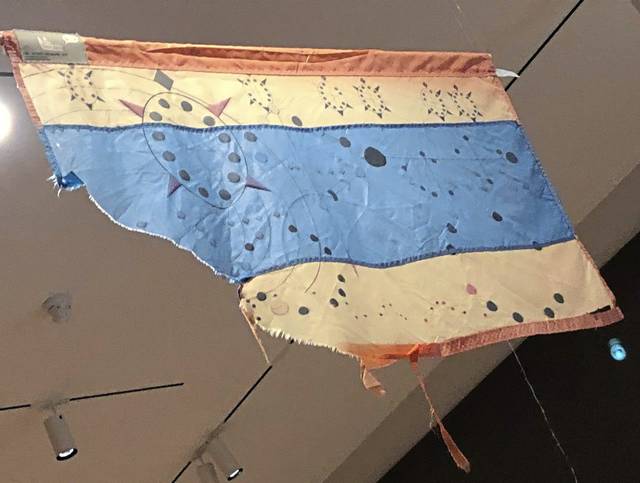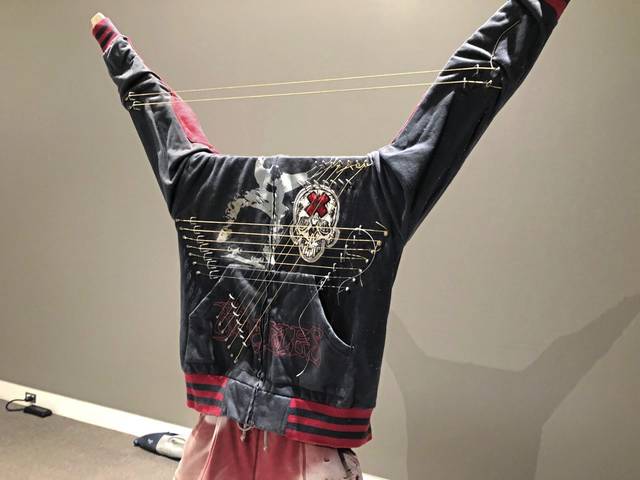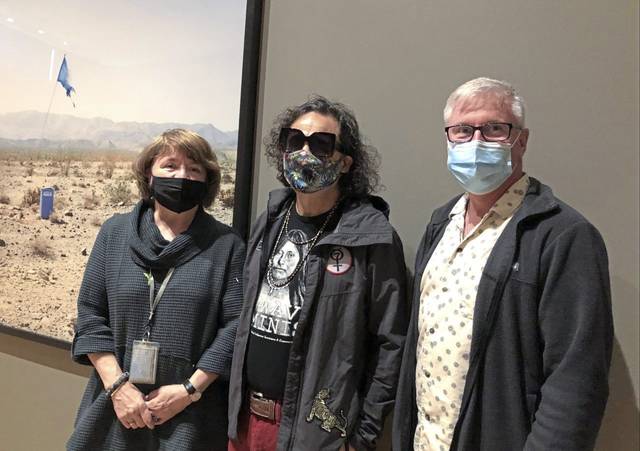Westmoreland Museum exhibit conveys experiences of southern U.S. border
Richard Misrach, a photographer based in the Bay Area of California, has been capturing images along the southern U.S. border for about 50 years.
“In 2004, he found a water barrel in the desert with a tattered flag hanging over it, and he didn’t know what it was,” said Barbara Jones, chief curator at The Westmoreland Museum of American Art. “He photographed it and found out later that it was a humanitarian group water station. They put these water barrels in the desert for migrants.
“This was a revelation for him, and it got him thinking about other aspects of the border,” she said.
That included the border wall, a study that ultimately led to “Border Cantos | Sonic Border,” a joint exhibition with another California-based artist, sculptor-composer Guillermo Galindo.
The exhibit runs Sunday through Sept. 5 in the Greensburg museum.
Misrach’s contribution to the exhibit is “Border Cantos,” a series of large-scale photographs capturing landscapes and signs of human experience along the almost 2,000-mile border — including the aspect of policing the boundary.
Galindo’s installation, “Sonic Border,” is an original score for eight instruments, created out of discarded objects collected along the border.
Found along the border
The collaboration began in 2011, after Misrach attended one of Galindo’s performances.
Misrach told Galindo about photographing things he’d found along the border, then started collecting and sending them to Galindo to incorporate into his musical instruments. Materials include plastic bottles, metal, clothing, Bible pages and others.
“What’s really interesting about these artists is that Richard sees the border and Guillermo hears it,” Jones said.
“Richard thought about his landscapes as cantos, basing that on the epic poem by Ezra Pound. When he started putting his photographs together, he saw they spoke to each other and created this relationship and told a story,” she said. “‘Canto’ also means ‘song’ in Spanish, which is a nod to the sound sculptures.”
Misrach’s cantos include eight thematic groupings called The Wall, Effigies, Target Practice, Cutting for Sign, Against the Wall, Agua, Artifacts and Other Side.
‘You can look at them as landscapes and see the underlying message. One of the artifacts is a child’s teddy bear that got left behind as they were crossing. Now, did they successfully cross? We don’t know,” Jones said. “It leaves quite a bit for you to think about and almost create your own narrative out of them.
“They’re not meant to be political at all or to state one side or the other. They’re really calling attention to what this entire border is,” she said. “We all know that the issues are big, we hear about it in the news weekly, if not every day. It reminds us that there’s more there than just the sound bites that end up on the news.”
Sound cycles
“Sonic Border” is based on the 260-day Mesoamerican “Venus calendar,” comprising 13 weeks of 20 days each. The sound cycle plays for 260 minutes, separated into 13 cycles of 20 minutes. Within these cycles, the instruments play in small groups or all together as an orchestra.
“It goes from soft, barely audible, to loud, so there’s this crescendo. It builds as you listen to it,” Jones said. “It runs continuously, so as you look at the photographs you’ll be able to hear it.
“He says his goal is not to obtain the most beautiful sound, but to allow the materials to sing in their own voices,” Jones said. “Guillermo says, ‘This expresses this internal journey evoking what is happening inside the hearts and minds of people who are crossing the border.’
“Guillermo talks about the idea of the sound connecting people,” she said.
The exhibit space also will include what Jones termed “an area of decompression,” giving visitors the opportunity to contemplate the images and to write or draw their own stories of moving to a new place.
Programming in conjunction with the exhibition includes a performance and question-and-answer session with Galindo, online at 7 p.m. today. Misrach will join Jones for an online conversation at 7 p.m. June 30.
Other virtual programming will include lectures on the history of the Mexican-American border, a cooking class and a “LatinX and Proud!” reading series. An outdoor dinner is planned at the museum on Aug. 7, in partnership with Community Kitchen Pittsburgh and highlighting dishes with distinct mother sauces from Central and South America.
Details are available on the museum website.
The traveling exhibit is organized by Crystal Bridges Museum of American Art in Bentonville, Arkansas, with additional loans courtesy of the artists and Magnolia Editions in Oakland, California.
Details: 724-837-1500 or thewestmoreland.org
Shirley McMarlin is a Tribune-Review staff writer. You can contact Shirley by email at smcmarlin@triblive.com or via Twitter .
Remove the ads from your TribLIVE reading experience but still support the journalists who create the content with TribLIVE Ad-Free.




